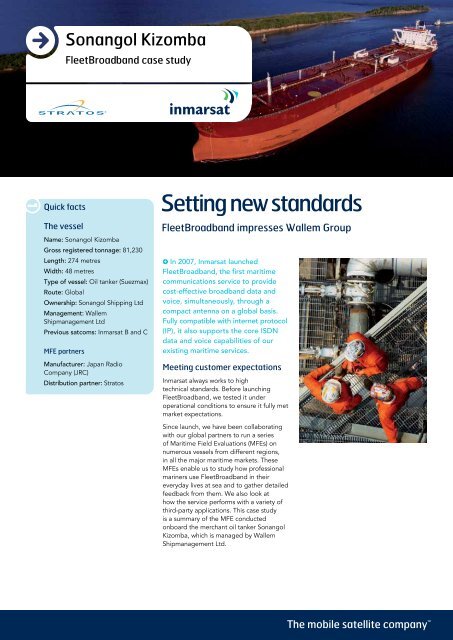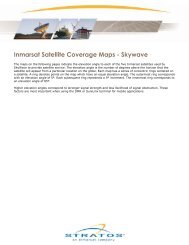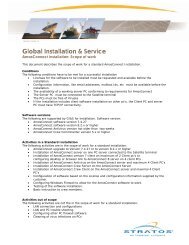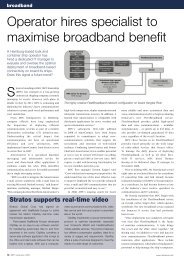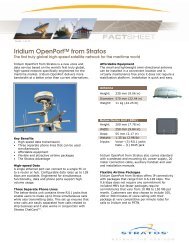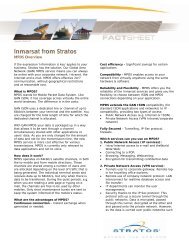Sonangol Kizomba - Stratos Global Corporation
Sonangol Kizomba - Stratos Global Corporation
Sonangol Kizomba - Stratos Global Corporation
You also want an ePaper? Increase the reach of your titles
YUMPU automatically turns print PDFs into web optimized ePapers that Google loves.
<strong>Sonangol</strong> <strong>Kizomba</strong><br />
FleetBroadband case study<br />
Quick facts<br />
The vessel<br />
Name: <strong>Sonangol</strong> <strong>Kizomba</strong><br />
Gross registered tonnage: 81,230<br />
Length: 274 metres<br />
Width: 48 metres<br />
Type of vessel: Oil tanker (Suezmax)<br />
Route: <strong>Global</strong><br />
Ownership: <strong>Sonangol</strong> Shipping Ltd<br />
Management: Wallem<br />
Shipmanagement Ltd<br />
Previous satcoms: Inmarsat B and C<br />
MFE partners<br />
Manufacturer: Japan Radio<br />
Company (JRC)<br />
Distribution partner: <strong>Stratos</strong><br />
Setting new standards<br />
FleetBroadband impresses Wallem Group<br />
In 2007, Inmarsat launched<br />
FleetBroadband, the first maritime<br />
communications service to provide<br />
cost-effective broadband data and<br />
voice, simultaneously, through a<br />
compact antenna on a global basis.<br />
Fully compatible with internet protocol<br />
(IP), it also supports the core ISDN<br />
data and voice capabilities of our<br />
existing maritime services.<br />
Meeting customer expectations<br />
Inmarsat always works to high<br />
technical standards. Before launching<br />
FleetBroadband, we tested it under<br />
operational conditions to ensure it fully met<br />
market expectations.<br />
Since launch, we have been collaborating<br />
with our global partners to run a series<br />
of Maritime Field Evaluations (MFEs) on<br />
numerous vessels from different regions,<br />
in all the major maritime markets. These<br />
MFEs enable us to study how professional<br />
mariners use FleetBroadband in their<br />
everyday lives at sea and to gather detailed<br />
feedback from them. We also look at<br />
how the service performs with a variety of<br />
third-party applications. This case study<br />
is a summary of the MFE conducted<br />
onboard the merchant oil tanker <strong>Sonangol</strong><br />
<strong>Kizomba</strong>, which is managed by Wallem<br />
Shipmanagement Ltd.<br />
The mobile satellite company
Assessing new technology<br />
Wallem Shipmanagement is part of the<br />
Wallem Group and is one of the world’s<br />
largest ship management companies.<br />
Based in Hong Kong, the group provides<br />
ship management, agency, broking and<br />
IT services to its clients worldwide. The<br />
company was established in1903 as a ship<br />
broking company in Shanghai by Norwegian<br />
founder Haakon Wallem. Today the company<br />
has 49 offices in 20 countries and territories,<br />
employing more than 8,500 people.<br />
Wallem has a reputation for investing in<br />
new technologies that will enhance the<br />
safety and efficiency of its vessels. So,<br />
when Inmarsat distribution partner <strong>Stratos</strong><br />
suggested it take part in a field evaluation<br />
for FleetBroadband, the company was<br />
happy to propose the <strong>Sonangol</strong> <strong>Kizomba</strong> as<br />
a participant. Wallem Innovative Solutions<br />
Director and Chief Information Officer<br />
Patrick Slesinger said: “The FleetBroadband<br />
MFE enabled us to trial a number of<br />
technologies that we had wanted to use in<br />
the past, but just didn't have the bandwidth<br />
for. FleetBroadband gave us bandwidth<br />
on demand, allowing us to re-engineer<br />
business processes that in the past would<br />
have been too bandwidth hungry.”<br />
About FleetBroadband<br />
Inmarsat’s latest maritime service<br />
offers broadband internet protocol<br />
(IP) data capability, backed by<br />
the power of the Inmarsat-4<br />
satellites. For the first time with<br />
FleetBroadband, users can make<br />
voice calls while simultaneously<br />
maintaining one or more<br />
data connections.<br />
Standard IP<br />
For email, internet and intranet<br />
access via a secure VPN connection,<br />
at speeds up to 432kbps over a<br />
shared channel.<br />
Streaming IP<br />
Guaranteed data rates on demand<br />
up to 256kbps. Choose the data rate<br />
on a case by case basis, depending<br />
on your application.<br />
Voice<br />
Make voice calls at the same time<br />
as accessing your data applications.<br />
Voicemail is also available.<br />
ISDN<br />
Supports ISDN at 64kbps for your<br />
legacy applications*. Group 3 and 4<br />
fax supported.<br />
SMS<br />
Send and receive text messages<br />
– up to 160 characters.<br />
*Only available on FB500
With a deadweight (DWT) of 159,165 –<br />
equivalent to just over one million barrels<br />
of crude oil – the <strong>Sonangol</strong> <strong>Kizomba</strong> is a<br />
mid-range tanker in the ‘Suezmax’ class,<br />
so named because she has the maximum<br />
width and draft to pass through the Suez<br />
Canal. During the two-month MFE in 2008,<br />
she was operating in the north-east Pacific<br />
Ocean, mainly off the coast of California.<br />
JRC installed a JRC FB250 FleetBroadband<br />
terminal on the <strong>Sonangol</strong> <strong>Kizomba</strong> while<br />
docked on the US west coast. According<br />
to Ian Parkes, Wallem Group Information<br />
Systems Manager, installation of the<br />
equipment and integration with existing<br />
onboard systems went smoothly.<br />
Wallem had two principal objectives for<br />
the MFE:<br />
• To assess how FleetBroadband could<br />
enhance the operational efficiency of the<br />
vessel, particularly by enabling closer<br />
integration with the Group’s onshore<br />
network and business communications<br />
• To evaluate the impact of the system<br />
on crew welfare. Ian Parkes said: “We<br />
wanted to look at how it would improve<br />
our business communications onboard,<br />
but equally, we are always looking for<br />
ways to improve the lives of our crew.”<br />
“The long-term goal of everyone in the<br />
maritime industry is to make life on board<br />
as close to life at home as possible for the<br />
crew, so whenever a vendor comes up with<br />
something new like this, we are always<br />
interested.”<br />
Ian Parks,<br />
Information Systems Manager<br />
Calm seas<br />
Like all large ocean-going vessels, the<br />
<strong>Sonangol</strong> <strong>Kizomba</strong> can save time and fuel<br />
by avoiding bad weather at sea. To do<br />
this effectively, the Master requires up-todate<br />
forecasts that allow him to plot routes<br />
that take advantage of calm seas and light<br />
headwinds. This is increasingly important<br />
when the price of bunker fuel is high.<br />
<strong>Stratos</strong> supplied its AmosConnect<br />
communications suite with FleetBroadband.<br />
This included a MAPI (messaging<br />
application programming interface) that<br />
supports the SPOS weather forecasting<br />
software package from Meteo Consult.<br />
SPOS automatically checks the Amos<br />
network onshore for the latest weather<br />
forecasts and emails any that are relevant<br />
to the vessel’s AmosConnect inbox. The<br />
files generated contain a complete weather<br />
forecast with high-quality data, including<br />
atmospheric pressure, wind direction, ocean<br />
currents and swell. While the standard<br />
charts are less that 1MB, larger forecast sets<br />
are also available on request. If the Master<br />
prefers not to receive charts by email, he<br />
can use FleetBroadband to access them<br />
manually from a FTP site on the internet.<br />
About AmosConnect<br />
AmosConnect is recognised as the<br />
maritime email standard, seamlessly<br />
integrating vessel and office<br />
applications deployed on more than<br />
10,000 vessels worldwide. It is optimised<br />
for ship-to-shore communications over<br />
FleetBroadband, so messages are sent<br />
in the fastest and most cost-effective<br />
format, using specialised satellite<br />
protocols and compression to make<br />
the most efficient use of bandwidth.
Real-time messaging<br />
FleetBroadband is a powerful and flexible<br />
communications system that supports a<br />
wide range of messaging options, including<br />
email, SMS and MSN. However, Wallem<br />
wanted to evaluate it with its own corporate<br />
messaging system, which is widely used<br />
across its shore offices. This takes the<br />
form of a screensaver, used to display<br />
corporate information on employees’ PCs.<br />
It’s powered by an application that sits on<br />
the Wallem network, broadcasting new<br />
messages in near real time.<br />
Inmarsat and <strong>Stratos</strong> worked with Wallem<br />
to make this messaging system available<br />
onboard the <strong>Sonangol</strong> <strong>Kizomba</strong> via<br />
FleetBroadband, enabling crew members to<br />
receive the messages at the same time as<br />
their colleagues on shore. Parkes said this<br />
was a great success and has real potential<br />
to enhance operational efficiency.<br />
“Normally, when you have large volumes<br />
of data coming on to a vessel, it is in the<br />
form of an email attachment, which has<br />
limitations in terms of timing, with people<br />
only checking their email a few times a day.<br />
With the FleetBroadband solution, if we<br />
receive an alert or some guidance we need<br />
to pass on, rather than burying it in the<br />
normal email traffic, we can push it out to<br />
the screens on the vessel.”<br />
Ian Parks,<br />
Information Systems Manager<br />
Wallem also successfully tested Yahoo<br />
Messenger as a tool for communicating<br />
in real time with crew on the <strong>Sonangol</strong><br />
<strong>Kizomba</strong>. Used as a system of ‘presence<br />
alerting’, this enabled managers on shore to<br />
be up-to-date on which crew members were<br />
on duty at any given time.<br />
Remote maintenance<br />
Another area in which Wallem evaluated<br />
the ability of FleetBroadband to integrate<br />
vessels with onshore systems was the<br />
updating of anti-virus software for the ship’s<br />
computers. The company has rigorous<br />
standards for PCs in its shore offices, with<br />
frequent and regular scheduled anti-virus<br />
updates. However, these are difficult to<br />
apply onboard a vessel at sea due to the<br />
difficulties of transferring relatively large<br />
updates over wireless links. This is not a<br />
problem with FleetBroadband, because<br />
files of several megabytes can be<br />
transferred in just a few minutes. Wallem<br />
used the MFE as an opportunity to deploy<br />
its standard anti-virus software – Kaspersky<br />
– on the <strong>Sonangol</strong> <strong>Kizomba</strong>’s IT network,<br />
scheduling regular software updates via<br />
FleetBroadband.<br />
Online support and diagnostics for the<br />
<strong>Sonangol</strong> <strong>Kizomba</strong>’s IT network were also<br />
provided via FleetBroadband. The Inmarsat<br />
team in London used the UltraVNC (virtual<br />
network computing) remote control<br />
and support tool to maintain onboard<br />
IT systems and software, configure WiFi<br />
routers and access points, and provide<br />
upgrades for the FleetBroadband terminal.<br />
In the past it would have been necessary<br />
to send an IT engineer onboard to perform<br />
these kinds of tasks.<br />
Remote maintenance for onboard IT<br />
systems has been possible for a number of<br />
years, but is impractical over low-bandwidth<br />
connections. However, several factors make<br />
remote maintenance much more viable over<br />
FleetBroadband:<br />
• Higher bandwidth means that large<br />
volumes of data are exchanged more<br />
quickly between the VNC program and<br />
the onboard PC<br />
• The option of on-demand Streaming<br />
IP ensures guaranteed bandwidth<br />
and a reliable connection throughout<br />
the remote-maintenance operation,<br />
if required for certain time-sensitive<br />
applications<br />
• FleetBroadband is based on IP (internet<br />
protocol) and so is fully compatible with<br />
all standard PCs and networks, providing<br />
seamless and instant connectivity<br />
• FleetBroadband supports multiple IP<br />
connections, so other data and voice<br />
channels can remain in use while remote<br />
maintenance is undertaken.
Video breakthrough<br />
Wallem tested several other applications<br />
with FleetBroadband, and was particularly<br />
interested in the potential of video. It used<br />
Polycom PVX over Streaming IP to test the<br />
system’s ability to support videoconferencing<br />
between the vessel in the Pacific and<br />
Stephen Yip, Wallem’s communications<br />
specialist, in Hong Kong. Yip said he could<br />
clearly hear and see the Master on the vessel<br />
and described it as “a leap forward in the<br />
application of this technology, particularly for<br />
commercial shipping.”<br />
The company also tested the potential of<br />
the Frontline Communicator as a tool for<br />
inspecting damage to equipment or cargo<br />
on the vessel. It enables a crew member<br />
to use a head-mounted video camera to<br />
transmit live images with audio commentary<br />
to a wireless access point on the vessel.<br />
The data is then streamed to shore in<br />
real time via FleetBroadband, enabling<br />
technicians there to review the images<br />
and commentary and provide immediate<br />
feedback on the problem.<br />
“Remote video diagnostics have the<br />
potential to reduce operational costs by<br />
helping us to minimise down time. In this<br />
market we need to make sure that the vessel<br />
is available for operational use at all times.”<br />
Patrick Slesinger,<br />
Director and CIO<br />
Meeting the crew welfare<br />
challenge<br />
A priority for Wallem was to use the MFE<br />
to explore the potential of FleetBroadband<br />
to provide flexible and cost-effective<br />
ship-to-shore communications for crew.<br />
This is particularly important in the<br />
operational environment of an oil tanker,<br />
which demands a high degree of skill and<br />
commitment from crew members to ensure<br />
the safe and efficient running of the ship.<br />
The ability to communicate regularly with<br />
family and friends can create a happier and<br />
more productive working environment. As a<br />
result, it can also help Wallem to recruit and<br />
retain high-quality employees.<br />
Wallem first made email and SMS<br />
messaging available to crew members in<br />
March 2006, with free email and inbound<br />
SMS, and low-cost outgoing SMS. Within<br />
a year, demand for the service had grown<br />
dramatically. This led the company to<br />
predict that broadband access would prove<br />
just as popular – if it were possible to make<br />
it available to crew cost-effectively.<br />
The MFE was an opportunity to test<br />
the theory. Crew were given access<br />
to PCs connected to the internet via<br />
FleetBroadband, replicating the unrestricted<br />
access that is now commonplace ashore.<br />
As expected, Internet browsing was<br />
welcomed with webmail, chat, news, sport,<br />
entertainment and self-improvement sites<br />
all proving popular.<br />
This type of feedback has proved extremely<br />
useful as Wallem has been able to respond<br />
with an improved Wallem Crew Connect<br />
email solution, Video-on-demand technical<br />
training onboard, and a subsequent trial of<br />
the GSM “mobile phone” solutions coming<br />
in to FleetBroadband in 2009 that address<br />
the needs for personal and private crew<br />
communication channels while onboard.<br />
“The system was very user-friendly and<br />
the crew was particularly grateful for the<br />
extra contact they enjoyed with their<br />
families. FleetBroadband has given us the<br />
opportunity to be closer to our families on<br />
this voyage, which boosts crew morale.”<br />
Captain R Kararia<br />
Key uses and benefits<br />
Weather routing to enhance<br />
operational efficiency<br />
The SPOS weather application within<br />
AmosConnect enabled the Master of the<br />
<strong>Sonangol</strong> <strong>Kizomba</strong> to access up-to-date<br />
forecasts. It can also be used to plot the<br />
optimum route to save fuel and avoid<br />
potential damage to the vessel, and to<br />
provide more accurate estimates of arrival<br />
times in port.<br />
Remote support<br />
The Inmarsat engineering team used<br />
FleetBroadband to provide regular<br />
updates for the <strong>Sonangol</strong> <strong>Kizomba</strong>’s antivirus<br />
software, to remotely configure the<br />
vessel’s IT network and to upgrade the<br />
FleetBroadband terminal.<br />
Messaging options<br />
FleetBroadband supports all standard<br />
messaging options, including email<br />
and SMS. It enabled Wallem to deploy<br />
its corporate screensaver messaging<br />
application on the <strong>Sonangol</strong> <strong>Kizomba</strong> while<br />
at sea, and supported a presence alerting<br />
service over Yahoo Messenger.<br />
Excellent voice quality<br />
The Master made use of FleetBroadband’s<br />
dedicated 4kbps voice channel and was<br />
impressed by its clarity and reliability.<br />
“FleetBroadband’s voice quality is far<br />
superior to anything Inmarsat has offered<br />
before and we are very pleased with it,”<br />
said Patrick Slesinger.<br />
<strong>Global</strong> coverage<br />
With the third Inmarsat-4 satellite<br />
operational over the Pacific Ocean,<br />
FleetBroadband coverage is now global.<br />
Patrick Slesinger said: “Inmarsat global<br />
coverage is very important to us. It's not just<br />
a question of not being able to speak to a<br />
vessel’s crew that is an inconvenience, we<br />
actually can't carry out business properly<br />
without that coverage.”
Video applications<br />
Wallem tested both videoconferencing<br />
using Polycom PVX and video using the<br />
Frontline Communicator inspection tool.<br />
The Master and shore-based employees<br />
were impressed by the quality of the live<br />
video images over Streaming IP.<br />
Ensuring crew welfare<br />
Wallem is committed to providing<br />
communications that help seafarers stay<br />
in contact with family and friends. During<br />
the MFE onboard the <strong>Sonangol</strong> <strong>Kizomba</strong>,<br />
FleetBroadband improved communications<br />
and was welcomed by the crew.<br />
“The crew commented very positively and<br />
said they felt far closer to their families and<br />
friends on shore. Obviously this has a very<br />
high impact on crew morale – and crew<br />
morale is linked to performance.”<br />
Patrick Slesinger,<br />
Director and CIO<br />
A perfect fit for the oil industry<br />
FleetBroadband provided a powerful and<br />
flexible communications solution for the<br />
<strong>Sonangol</strong> <strong>Kizomba</strong>, demonstrating that it<br />
can ably support the operational and crew<br />
welfare requirements of a modern oil tanker.<br />
How to buy FleetBroadband<br />
FleetBroadband is available through<br />
Inmarsat’s worldwide network of partners.<br />
Contact your existing Inmarsat service<br />
provider or visit our website to find the right<br />
partner for your company.<br />
inmarsat.com/merchant<br />
Whilst the above information has been prepared by Inmarsat in good faith, and all reasonable efforts have been made to ensure its accuracy, Inmarsat makes no warranty or representation<br />
as to the accuracy, completeness or fitness for purpose or use of the information. Inmarsat shall not be liable for any loss or damage of any kind, including indirect or consequential loss,<br />
arising from use of the information and all warranties and conditions, whether express or implied by statute, common law or otherwise, are hereby excluded to the extent permitted by<br />
English law. INMARSAT is a trademark of the International Mobile Satellite Organisation, Inmarsat LOGO is a trademark of Inmarsat (IP) Company Limited. Both trademarks are licensed to<br />
Inmarsat <strong>Global</strong> Limited. © Inmarsat <strong>Global</strong> Limited 2010. All rights reserved. <strong>Sonangol</strong> <strong>Kizomba</strong> January 2010.


